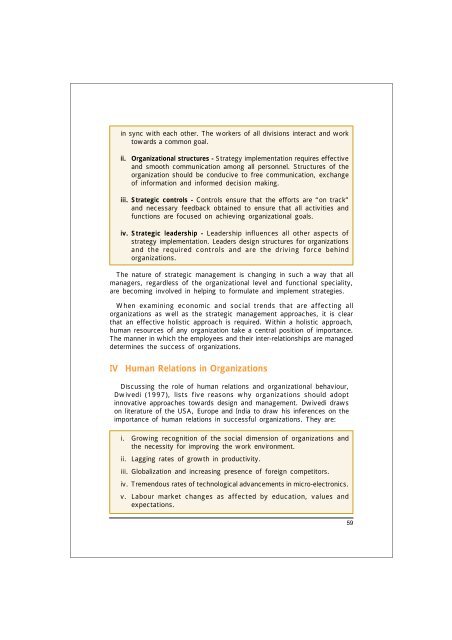Beyond Glass Ceilings and Brick Walls - International Labour ...
Beyond Glass Ceilings and Brick Walls - International Labour ...
Beyond Glass Ceilings and Brick Walls - International Labour ...
Create successful ePaper yourself
Turn your PDF publications into a flip-book with our unique Google optimized e-Paper software.
in sync with each other. The workers of all divisions interact <strong>and</strong> work<br />
towards a common goal.<br />
ii. Organizational structures - Strategy implementation requires effective<br />
<strong>and</strong> smooth communication among all personnel. Structures of the<br />
organization should be conducive to free communication, exchange<br />
of information <strong>and</strong> informed decision making.<br />
iii. Strategic controls - Controls ensure that the efforts are “on track”<br />
<strong>and</strong> necessary feedback obtained to ensure that all activities <strong>and</strong><br />
functions are focused on achieving organizational goals.<br />
iv. Strategic leadership - Leadership influences all other aspects of<br />
strategy implementation. Leaders design structures for organizations<br />
<strong>and</strong> the required controls <strong>and</strong> are the driving force behind<br />
organizations.<br />
The nature of strategic management is changing in such a way that all<br />
managers, regardless of the organizational level <strong>and</strong> functional speciality,<br />
are becoming involved in helping to formulate <strong>and</strong> implement strategies.<br />
When examining economic <strong>and</strong> social trends that are affecting all<br />
organizations as well as the strategic management approaches, it is clear<br />
that an effective holistic approach is required. Within a holistic approach,<br />
human resources of any organization take a central position of importance.<br />
The manner in which the employees <strong>and</strong> their inter-relationships are managed<br />
determines the success of organizations.<br />
IV Human Relations in Organizations<br />
Discussing the role of human relations <strong>and</strong> organizational behaviour,<br />
Dwivedi (1997), lists five reasons why organizations should adopt<br />
innovative approaches towards design <strong>and</strong> management. Dwivedi draws<br />
on literature of the USA, Europe <strong>and</strong> India to draw his inferences on the<br />
importance of human relations in successful organizations. They are:<br />
i. Growing recognition of the social dimension of organizations <strong>and</strong><br />
the necessity for improving the work environment.<br />
ii. Lagging rates of growth in productivity.<br />
iii. Globalization <strong>and</strong> increasing presence of foreign competitors.<br />
iv. Tremendous rates of technological advancements in micro-electronics.<br />
v. <strong>Labour</strong> market changes as affected by education, values <strong>and</strong><br />
expectations.<br />
59
















